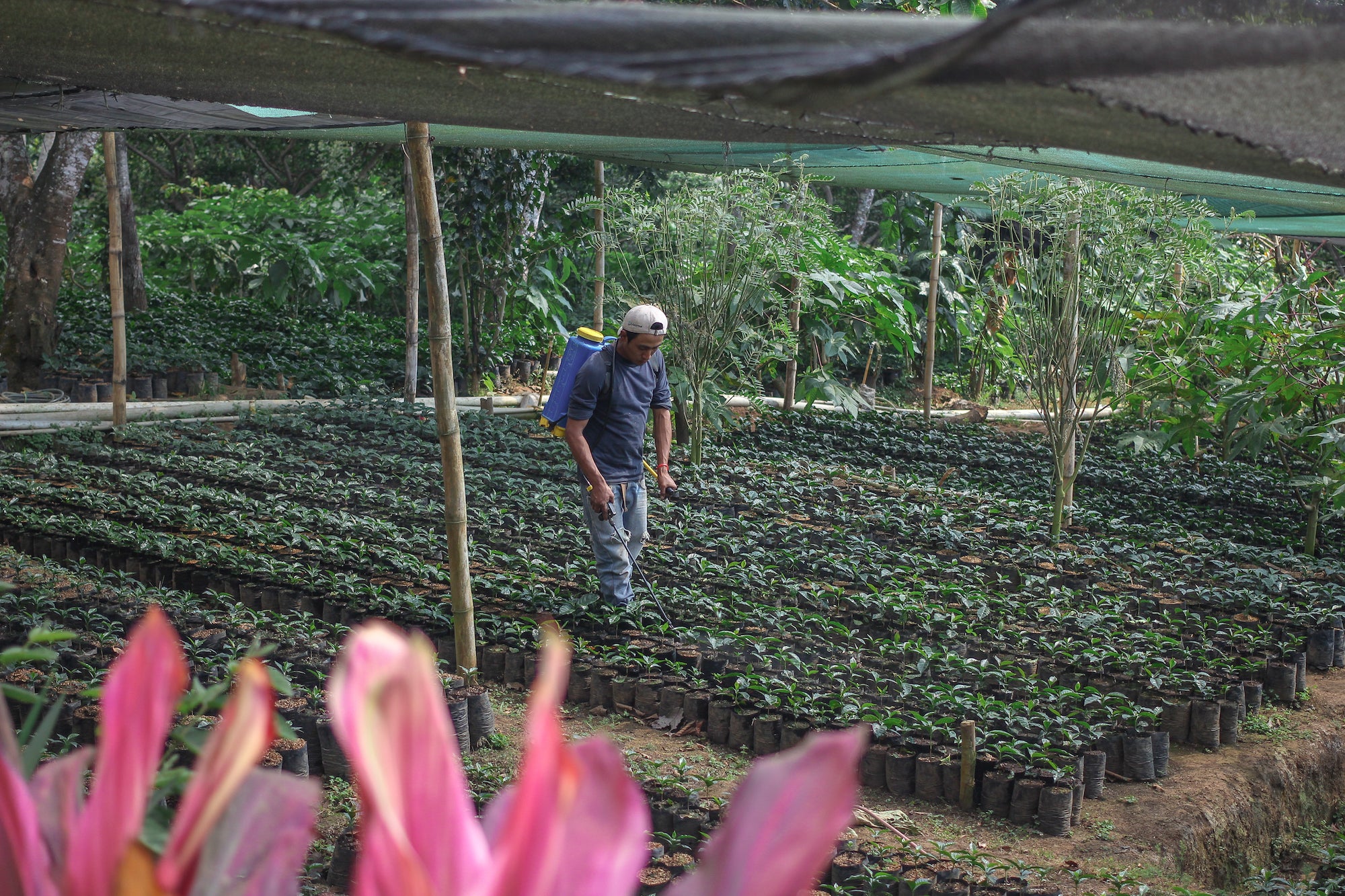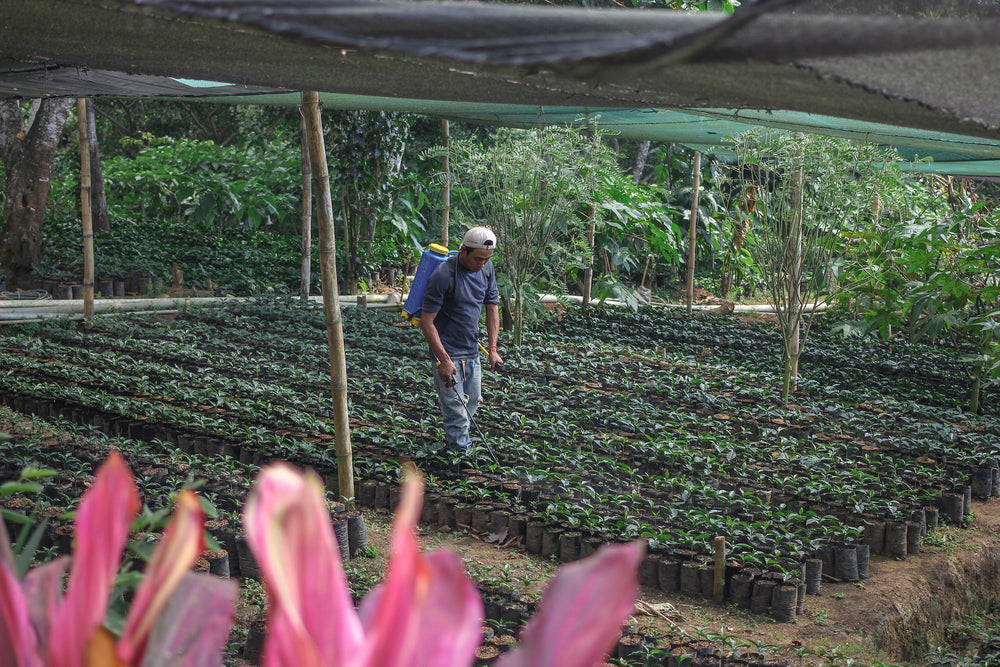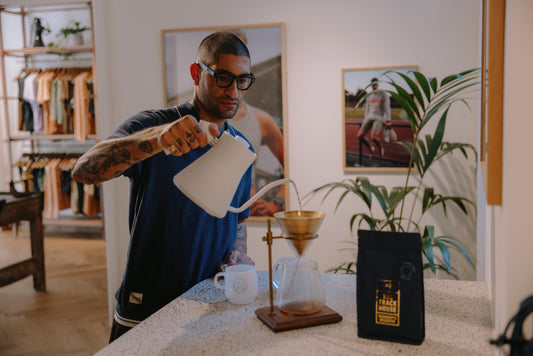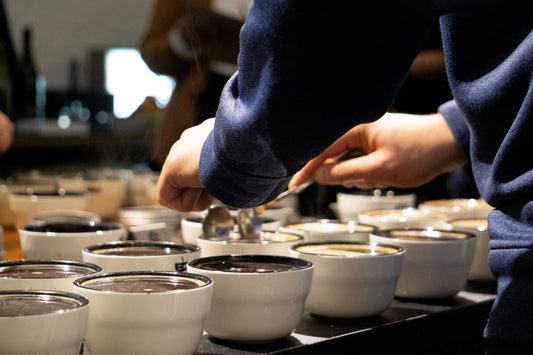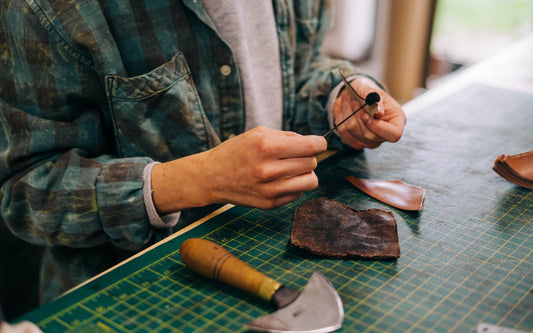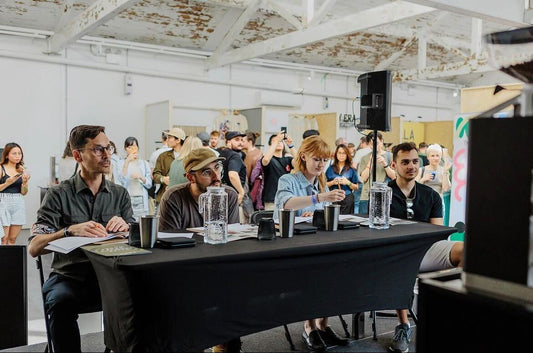
Coffee seedlings being tended at a JASAL nursery, Santa Ana, El Salvador.
The constant availability of quality coffee is not a foregone conclusion. Like many other species of flora and fauna across the world, it is under threat. Climate change, pests, disease, drastic swings in crop output and numerous other factors all have the potential to substantially affect the long-term viability of the product we love so dearly.
We want to ensure we're doing all we can to guarantee its future, which is why, for the last eighteen months, we've included a donation to World Coffee Research (WCR) for each kilo of green coffee we purchase from Nordic Approach, Caravela and Café Imports. Having established themselves intending to grow, protect and enhance supplies of quality coffee, we see the work WCR are doing as vital if we want to continue enjoying the best coffee possible. Our Head of Quality, James Bailey, offers greater insight into the initiative and the positive impacts it's already beginning to have.
Journalists tend to cover one of three topics when the time comes around for a new article on coffee: new research proclaiming health benefits, conflicting research that says coffee is bad for you, or an increasingly common topic worthier of your attention; coffee is in peril.
Due to the scale of the supply chain from farmer to consumer, one in sixty people on the planet relies on coffee for their daily income. Whilst 70% of coffee produced globally is by smallholders with less than five hectares of land, demand still grows. Regions historically suitable for coffee production are now encountering new challenges; increasing costs of production and lower yields, to greater susceptibility to both pests and diseases, all are making it harder for supply to meet demand.
And, of course, drastic changes to climate patterns fuel the fire of these challenges, casting a shadow of doubt on our coffee-growing future.
When you look at the history of coffee propagation around the world, you can begin to understand why the crop's future hangs in the balance. Originally taken to Yemen by Arabic Traders in the 15th century from the genetically diverse range of varieties native to Ethiopia, a handful of what we now call Bourbon and Typica plants then made their way to India along the existing trade routes in c.1670. The Typica variety travelled the globe, via Indonesia to the Caribbean arriving sometime between c.1700 to c.1720, whilst Bourbon took a different path, leaving Yemen in c.1720, travelling to Île Réunion (then Île Bourbon), before finally arriving in South America in the middle of the 19th century.

Newly germinated coffee plants, Cauca, Colombia.
These two plants, which represent a tiny proportion of the diversity of the wild forest coffee that still grows in Ethiopia, are responsible for populating Asia and the Americas before coffee even spread to other countries in Africa. From c.1890 to c.1950, countries like Tanzania, Kenya, Rwanda, Burundi and Malawi saw varieties entering from Yemen, India, Jamaica, the Americas and Île Réunion. These, however, are all from the first small group of Bourbon and Typica varieties taken from Ethiopia in the 15th century, so even East Africa is historically populated with coffee from the same shallow gene pool as the rest of the world.
This lack of genetic diversity, as typified with the Cavendish Banana, increases the risk of precarious monocultures collapsing and is being documented more and more frequently as farming intensifies globally.
Coffee has often been described as an orphan crop and for a good reason. The absence of research into coffee varieties, with no one group, body or organisation stepping in to oversee and ensure its long-term success as a crop, has meant the development of new coffee varieties is extremely far behind when compared to other commercial food crops. From 125 known wild species of coffee, fewer than 60 varieties of arabica and robusta have been developed to support global demand. It's a huge contrast when held up against other farmed crops: from 6 wild species of maize, 20,000 varieties have been developed; 62 native apple species have birthed 7,500 cultivated varieties, and a somewhat obscure point of comparison, there are 2,690 varieties of watermelon, and yet global coffee trade is 142 times larger than the world's demand for watermelons.
To make it even harder, coffee seeds cannot be indefinitely stored for future use in a seed bank such as the Svalbard Global 'Doomsday Vault' Seed Bank in the way most other plant seeds can. That’s because, over time, coffee seeds degrade and ultimately lose their viability to germinate.
However, WCR has a solution to this; a living, breathing 'seed bank'.

Experimental F1 hybrids await planting at a WCR Farm, El Salvador. (Photo credit: Sara Bogantes)
Currently conducting 31 International Multi-Locational Variety Trials (IMLVTs) in 22 countries around the world, WCR has planted the same 31 arabica coffee varieties in each IMLVT. This allows for analysis across a range of conditions that include elevation, soil type, sunshine hours, degrees of shade, rainfall and temperature. No program has ever achieved this level of cooperation across the world's growing regions and already the trials are beginning to give results. In 2018, first harvests were seen at 21 of the IMLVTs with coffee cherry adorning their trees; the ultimate reason for the research. Information had been gleaned before this time, however, such as when a hard frost wiped out almost all the varieties planted on an IMLVT in Laos and led to them being able to identify a group of F1 hybrid varieties which possess frost tolerance.
These trials aim to identify the optimal varieties a farmer should plant depending on the conditions found in their locale. World Coffee Research hopes this work will also allow them to steer coffee producers onto the right path when it comes to their agricultural practices, minimising the use of inputs and increasing both the quantity and quality of yields, especially as climate degradation begins to change the world we live in.

Laboratory-grown F1 Hybrids in development. (Photo credit: WCR)
Taking decisive, affirmative action to establish themselves as the world leader in coffee variety research, WCR have set themselves an audacious goal in the process: to develop varieties of coffee which are high yielding and demonstrably resilient in the field, whilst at the same time, delicious. Three traits that don't typically go hand-in-hand, hardiness in the field and resistance to certain pests and diseases are commonly associated with hybrids such as Catimor, which contain Robusta genes and cannot shake their reputation for poorer cup quality. WCR is combining the best qualities of some of the traditional adapted varieties, such as Caturra (mutated from Bourbon) and Maragogype (mutated from Typica), with new genes introduced from Ethiopia, as well as those hardy lines from a robusta lineage such as Sarchimors and Catimors. The difference is that they are focussing first and foremost on cup quality, with the bonus of improved hardiness and increased yields, even when growing under shade, simply additional agronomical benefits.
The first of the commercially available F1 hybrids (F1 designating a first generation crossing of genetically distinct parent plants) were developed just before WCR's time, in around 2010. We have since seen these early F1 types, along with newer varieties WCR have been working on, now appearing on cupping tables during our visits to Central America. Marsellesa (an early Sarchimor fixed line developed by CIRAD-ECOM), Centroamericano (F1 hybrid of Sarchimor and Rume Sudan) and Starmaya (CIRAD-ECOM developed F1 Hybrid which can be propagated by seed) are quickly becoming part of the ongoing conversation into coffee varieties both with farmers and buyers alike, being planted in significant volumes thanks not just to their resilience, but their success in cupping competitions. In the 2018 Nicaraguan Cup of Excellence competition, 9 of the top 20 coffees were F1 hybrids and that success is only expected to increase. With a plan to commercially release the next wave of F1s in 2025, the work being done by WCR is, in our eyes, crucial to the continuation of the supply of delicious coffees into a future we can't predict.

Marsellesa (Villa Sarchí x Hybrido Timor hybrid), planted at Aquiares Estate, Turrialba, Costa Rica.
All of this costs money. In the past year, WCR has spent over $3.2m doing its work globally. Since we became a partner at the end of 2017, Workshop Coffee has contributed over $12,000 to WCR, raised through the purchase of every kilo of green coffee we buy from Nordic Approach, Caravela and Café Imports, helping fund their research. Even better, Caravela and Café Imports are very generously matching that amount, further increasing the contribution.
The reason we've chosen to include this as part of the total cost of our green coffee purchases is that we see it as crucial in this ever-changing world. Investing in the research and development of coffee varieties suited to a range of climates, that are resistant to pests and diseases, and are capable of delivering a good cup profile seems, to us, to be the right horse to back. As WCR put it, investment into agricultural research is "as far upstream as it's possible to go", which means that a slightly increased cost per kilo of green coffee for us has the ability to aid in the research and development of coffee varieties, their optimal propagation and an impact on the global coffee production chain. The ongoing results from WCR's work will be so widespread as to potentially help every coffee producer on the planet, arming them with tools, information, materials and greater control over their own, and ultimately our futures in coffee.
Share:


